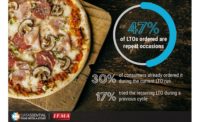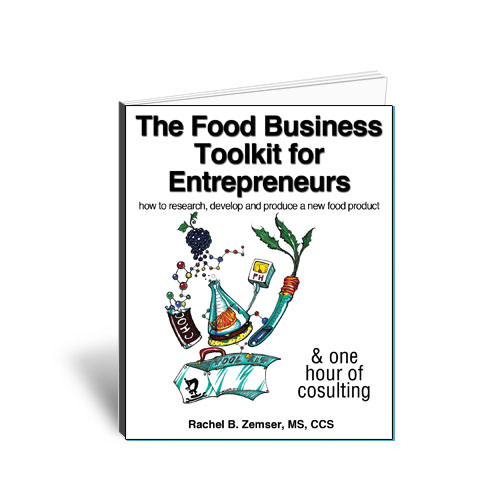Foodservice—at Home
IFMA and Datassential examine the growth and potential of foodservice at home

Foodservice at home was once limited to the supermarket’s home meal replacements (HMR) and the few restaurants that offered carryout or delivery.

Consumers rank convenience as the primary advantage of dining away-from-home compared to cooking at home.

With the average consumer eating more than 13 meals a week at home, there is still tremendous opportunity to grow within the foodservice-at-home market.

Perry Miele, president, Nestlé Professional North America and chairman for IFMA’s Consumer Planning Program

IFMA Consumer Planning Program Committee Members

Larry Oberkfell, President & CEO, IFMA






Whether it’s the proliferation of delivery options, our increasingly busy lifestyle, or the allure of eating with the company of Netflix, foodservice at home is rapidly growing and is poised to dramatically impact the industry.
Operators and retailers across segments are all finding their way into the mix, improving their offerings by partnering with third-party delivery providers, expanding to-go options, or offering reheatable meals for consumers to enjoy in the comfort of their homes. With an abundance of ordering portals and meal kit delivery services, manufacturers, operators, and retailers must understand the challenges and opportunities—in order to strategically develop a strong at-home program.
This topic was one of the 15 topics covered in the International Foodservice Manufacturers Association’s Consumer Planning Program (CPP), a year-long research study conducted in partnership with Datassential, a foodservice trends and data research firm based in Chicago.
Options
Foodservice at home was once limited to the supermarket’s home meal replacements (HMR) and the few restaurants that offered carryout or delivery. For many families, these foodservice-at-home occasions were rare—indicating a special night or exhausted adults.
Now, restaurants and retail outlets understand that consumers want a restaurant-quality meal within their home and often want their night-in to mimic a night-out. This has led to more restaurants offering delivery. More importantly, it has forced the industry to reevaluate the consumer experience from beginning to end in order to create an enjoyable and memorable meal. This spurred a new focus on take-out containers, marketing messages, crowdsourced delivery, collaboration with online ordering partners, as well as websites or smartphone apps that prioritize ease of ordering.
Inevitably, growth in demand results in growth in supply. Whether seeking a burger from a fast food restaurant, ordering a gourmet meal from a fine dining establishment, or cooking at home with the help of a meal kit, there are plenty of options for curious consumers.
The classic hot meal is ubiquitous—a snack or entrée from any establishment that is ready to be enjoyed immediately. Many manufacturers are developing refrigerated meals that feature premium ingredients and on-trend flavors. These meals can be bought many ways, but are often found on-site or within retail, and must be heated before serving. Frozen meals have always been abundantly available in the supermarket aisle and many restaurants—including Bob Evans, California Pizza Kitchen, and Chili’s At Home—have their entrees available to be taken home, stored in the freezer and reheated whenever it is convenient. Grocery stores, eager to capture more share of stomach, have also improved their frozen offerings under their own brand names. Scratch meal kits have taken the industry by storm with a simple premise: a recipe and all the necessary ingredients are portioned and packaged for a consumer to cook themselves. Customers that want the connection of cooking but don’t have much time to spare are gravitating towards prepared meal kits, which offer transparency but the components are pre-made, with prep time only taking about 10 minutes.
When asked about the key advantages of dining away-from-home compared to cooking at home, consumers ranked convenience as the primary advantage. More than two-thirds reported that the convenience of not having to cook (68%) was a key advantage, more than half said the same about not having to clean or do dishes (58%) and that the appeal of a fast meal drove them to seek a meal away from home (51%).
These answers indicate that customers often source meals away from home when they are looking for relief from the labor-intensity of cooking. Once foodservice establishments may have tried to coax these tired consumers off their couch to visit their establishment. However, with so many foodservice-at-home options available, operators and retailers must alter their strategy.
The marketing messaging can no longer be limited to drawing the customer out – now the communication must convince the customer to welcome them in. The success of third-party delivery sites, such as GrubHub, Seamless and UberEats, shows how willing consumers are to open their doors if there’s a meal on the other side of it.
Execution
Across segments, operators and retailers are catering to consumers seeking a home meal replacement. During the past several years, grocery stores have expanded their hot and cold options to establish themselves as “grocerants.” Whole Foods, Eataly and Mariano’s are becoming dinner destinations as much as supermarkets and they feature made-to-order delicacies and wine bars. Markets like Trader Joe’s, with limited prepared meals, are investing in frozen and refrigerated fare, offering modern meals in a frozen format. With restaurants encroaching on retail territory, it’s no surprise that grocers are beginning to mimic restaurants.
Supermarkets aren’t the only retail segment that sees the potential in this category. Convenience stores and drug stores are jumping into the fray with meal deals and delivery solutions. For example, Casey’s General Store offers a family-style bundle of a large pizza, an order of wings and a side of breadsticks for a low price. Drug stores—such as Walgreens’ flagship Chicago store—are offering everything from frozen yogurt to freshly made sushi, and providing customers with seating areas within the store. Amazon Fresh, already making a splash with their grocery delivery, will be leveraging their partnership with Tyson to expand into meal kits to capture even more of the at-home market.
Casual dining restaurants have been expanding their take-out services by offering amenities such as curb-side pick-up and error-free ordering through websites and mobile apps. Olive Garden is catering to customers that want a night out and predict the need for a night in with Buy-One-Take-One specials, where customers enjoy a meal on-site and get one to-go.
Limited service restaurants, whose speed once was the key component to their convenience, are now competing with the plethora of grab-and-go options and some restaurants such as Chipotle, Burger King and Dunkin Donuts are experimenting with delivery. GrubHub and Seamless prove the power of the smartphone, these innovative apps have changed delivery and niche markets are being mined for potential programs. TryCaviar, for example, coordinates delivery of food from fine dining establishments in select metro markets.
The overwhelming success of companies such as Blue Apron and Hello Fresh proves that there is a market for meal kit solutions. Purple Carrot, for example, has the same business model but exclusively offers plant-based meals that are quickly and easily prepared at home. Many regional meal kit services are popping up, and although they have a much smaller delivery radius, they are able to offer locally sourced products and ingredients preferred by their region.
Foodservice at home is so successful, some operations are eschewing a traditional brick-and-mortar location all together. Sprig was designed purely to deliver meals. Several chef-created meals are available every day and can be delivered to home or work by ordering through the app. Meanwhile, Snap Kitchen proves that you don’t need an on-site kitchen to cater to customers. This operation exclusively offers ready-to-eat carryout meals that simply need to be microwaved and served.
While these new concepts are currently limited to a few markets, it speaks volumes of the potential of foodservice at home and the multitude of ways to reach the consumer.
Demand
Despite growing usage and interest in foodservice at home, consumers still source the majority of their meals from home.
In an average week, a consumer will eat dinner from home five times, purchase it away from home 1.6 times and skip dinner for the remainder. Consumers are slightly more likely to get lunch away from home, with a weekly average of 1.7 lunches away from home. Although there is an abundance of options, there is still room to grow. With the average consumer eating more than 13 meals a week at home, there is still tremendous opportunity to grow within the foodservice-at-home market.
In order to grow, manufacturers and operators must understand what is preventing consumers from going out or ordering in. When asked to compare getting a meal away from home compared to cooking at home, 70% of consumers said that getting a meal away from home was more expensive. Consumers also believe a meal away from home as less healthy (41%) and nearly one-third considered it a drawback that they don’t really know what’s in the food.
Certainly messages of value, menus that cater to dietary restrictions, and build-you-own meal kits are all designed to minimize these perceived drawbacks. However, foodservice establishments must continue to address these concerns in their messaging.
With so many options in the market, customers will inevitably find products that target their key concerns, interests, and preferences in a meal. Meal Kits and grocerants are partnering with chefs to offer high-quality cuisine in the customer’s kitchen. Overall, HMR options are becoming more universal as they feature on-trend ingredients and mouth-watering recipes. New models for ordering and delivery are popping up while the level of quality continues to increase. Even so, the elevation of “foodservice at home” is still new to the industry. Expect it to be an even stronger force in the future of foodservice.
Strategy/Conclusion
Although it may seem as if the market is saturated with options, it is only just beginning to reach its potential. Consumers crave convenience, affordability, and they increasingly value the luxury of enjoying a restaurant-quality meal in their home. Billions of dollars have been invested in food delivery startups during the past three years and consumers – as well as the industry – are eager for the next big idea.
While there is significant room to grow in terms of ease-of-use and consumer engagement, operators and suppliers that understand the consumer’s motivation—will stand the best chance of reaching the consumer on their couch.
For more information about “Foodservice at Home” or the Consumer Planning Program, contact Julie Heseman (Julie@ifmaworld.com) or Adrienne Nadeau (Adrienne.Nadeau@datassential.com).
Originally appeared in the August, 2016 issue of Prepared Foods as Foodservice—at Home.
CPP: A Processor Perspective
Prepared Foods talks with Perry Miele, president, Nestlé Professional North America; and chairman for IFMA’s Consumer Planning Program. Nestlé Professional, Solon, Ohio, offers branded and custom prepared foodservice entrees and side dishes, sauces and bases, desserts, coffees, teas, juices and other beverages. Its brands include Minor’s, Stouffer’s, Nescafe, Coffee-mate, Chef-mate and Trio.
Prepared Foods: What has Nestlé Professional learned from IFMA’s Consumer Planning Program?
Perry Miele: By collaborating with IFMA’s Consumer Planning Program, Nestlé Professional has been able to connect with other industry leaders to share ideas and learn more about what works. We also hear about the challenges others face. We get to learn from each other in a way that elevates the entire industry and enables everyone to benefit.
PF: How does CPP help you support foodservice operator customers?
Miele: A few years ago, it was becoming very clear that the definition of “nutrition on the menu” was very different from the definition of nutrition at home.
Utilizing CPP insights, along with our own data, Nestlé Professional was able to identify the types of nutrition, health and wellness solutions that would be meaningful to consumers. We were able to help our valued operators identify areas of opportunity on their own menus and provide the solutions they needed to grow their business.
PF: How has CPP informed product development for end consumers?
Miele: Our Minor’s Ready-to-Flavor products are a good example of using CPP data to deliver products that directly address our consumers’ needs. Food safety is a major concern for consumers when eating away from home. But it’s not their only concern. They also want great flavor, convenience and the ability to customize their meal choices. CPP insights helped us identify product benefits that will drive consumer menu choices.
PF: How might CPP evolve in the coming year? Why should non-members consider joining IFMA?
Miele: Each year, the data becomes more relevant and more actionable. When CPP started, it was important to get all of the members up to speed and there was a learning curve.
Now, we are identifying opportunities for 28 different out-of-home eating occasions within 17 different operator segments. Participants can use these insights to help their business understand what motivates and challenges their operators and consumers, and build segment-specific strategies to help their business grow.
Innovation Needs Insight: Studies Eye At-Home Consumer
Until recently, foodservice operators and manufacturers segmented consumers by time of day or by other demographic breakouts. Each business would then define their own consumer segments to target and then be tasked with trying to align definitions.
Since today’s food consumer has drastically transformed, the IFMA Consumer Planning Program (CPP) Committee was formed to address the growing needs of the industry with richer, smarter, bigger original consumer data. As a means to address these challenges, the committee sources an annual research study to better determine the motivations and behaviors behind the consumer’s choice.
The IFMA Consumer Planning Program committee partners with Datassential to delve deeper into the consumer mindset, to find out why consumers pick a foodservice venue, how those decisions are made and what manufacturers and operators can do to influence those decisions. This original research is ground breaking and is the first real advance in understanding the “why” not just the “what” of foodservice consumer behavior.
CPP Committee Members are the smartest insights leaders in the foodservice industry. They steer the direction of the new research each year, submitting and voting on 14 topics to be covered in each year’s study. In 2015, the committee decided one such topic should be “Foodservice at Home,” providing a deeper understanding of how to impact consumer behavior when they aren’t dining outside their homes. With the blurring lines of traditional retail, the rise of meal kits, and the prevalence of third-party delivery options and restaurant to-go programs, Foodservice at Home is a growing opportunity for winning the consumer food dollar.
We strongly encourage you to become a member of the IFMA Consumer Planning Program.
To learn more about IFMA, the CPP and all the benefits of participating in this research effort, please visit ifmaworld.com.
Looking for a reprint of this article?
From high-res PDFs to custom plaques, order your copy today!












